simulate
Simulate sample paths of Markov-switching dynamic regression model
Description
Y = simulate(Mdl,numObs,Name,Value)'NumPaths',1000,'Y0',Y0 simulates 1000 sample paths and initializes the dynamic component of each submodel by using the presample response data Y0.
[ also returns the simulated innovation paths Y,E,StatePaths] = simulate(___)E and the simulated state paths StatePaths, using any of the input argument combinations in the previous syntaxes.
Examples
Simulate a response path from a two-state Markov-switching dynamic regression model for a 1-D response process. This example uses arbitrary parameter values.
Create Fully Specified Model
Create a two-state discrete-time Markov chain model that describes the regime switching mechanism. Label the regimes.
P = [0.9 0.1; 0.3 0.7]; mc = dtmc(P,'StateNames',["Expansion" "Recession"]);
mc is a fully specified dtmc object.
For each regime, use arima to create an AR model that describes the response process within the regime. Store the submodels in a vector.
mdl1 = arima('Constant',5,'AR',[0.3 0.2],... 'Variance',2); mdl2 = arima('Constant',-5,'AR',0.1,... 'Variance',1); mdl = [mdl1; mdl2];
mdl1 and mdl2 are fully specified arima objects.
Create a Markov-switching dynamic regression model from the switching mechanism mc and the vector of submodels mdl.
Mdl = msVAR(mc,mdl);
Mdl is a fully specified msVAR object.
Simulate Response Path
Generate one random response path of length 50 from the model.
rng(1); % For reproducibility
y = simulate(Mdl,50);y is a 50-by-1 vector of one response path.
Plot the response path.
figure plot(y) xlabel("Time") ylabel("Response")
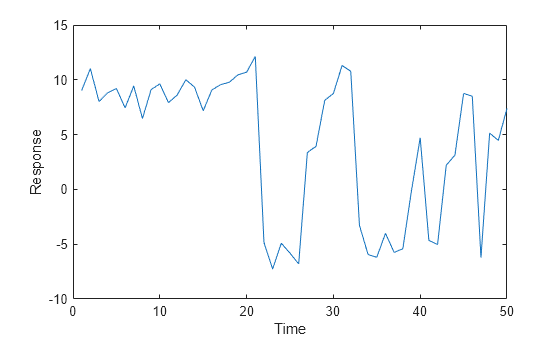
Consider the model in Simulate Response Path.
Create the Markov-switching dynamic regression model.
P = [0.9 0.1; 0.3 0.7]; mc = dtmc(P,'StateNames',["Expansion" "Recession"]); mdl1 = arima('Constant',5,'AR',[0.3 0.2],... 'Variance',2); mdl2 = arima('Constant',-5,'AR',0.1,... 'Variance',1); mdl = [mdl1; mdl2]; Mdl = msVAR(mc,mdl);
Simulate 3 response, innovations, and state-index paths of 5 observations from the model.
rng('default') % For reproducibility [Y,E,SP] = simulate(Mdl,5,'NumPaths',3)
Y = 5×3
-5.7605 10.9496 11.4633
-5.7002 8.5772 -3.1268
4.2446 10.7774 -5.6161
-3.1665 -2.2920 -5.2677
-3.8995 -4.7403 -6.3141
E = 5×3
-0.2050 0.9496 1.4633
-0.1241 -1.7076 0.7269
2.1068 1.0143 -0.3034
1.4090 1.6302 0.2939
1.4172 0.4889 -0.7873
SP = 5×3
2 1 1
2 1 2
1 1 2
2 2 2
2 2 2
Y, E, and SP are 5-by-3 matrices. Columns represent separate, independent paths.
Simulate a single path of responses, innovations, and states into a simulation horizon of length 50. Then plot each path separately.
[y,e,sp] = simulate(Mdl,50); figure subplot(3,1,1) plot(y) ylabel('Response') grid on subplot(3,1,2) plot(e) ylabel('Innovation') grid on subplot(3,1,3) plot(sp,'m') ylabel('State') yticks([1 2]) yticklabels(Mdl.StateNames)
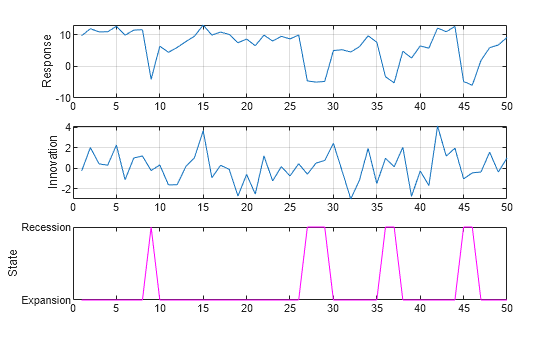
Consider a two-state Markov-switching dynamic regression model of the postwar US real GDP growth rate. The model has the parameter estimates presented in [1].
Create a discrete-time Markov chain model that describes the regime switching mechanism. Label the regimes.
P = [0.92 0.08; 0.26 0.74]; mc = dtmc(P,'StateNames',["Expansion" "Recession"]);
Create separate AR(0) models (constant only) for the two regimes.
sigma = 3.34; % Homoscedastic models across states mdl1 = arima('Constant',4.62,'Variance',sigma^2); mdl2 = arima('Constant',-0.48,'Variance',sigma^2); mdl = [mdl1 mdl2];
Create the Markov-switching dynamic regression model that describes the behavior of the US GDP growth rate.
Mdl = msVAR(mc,mdl);
Mdl is a fully specified msVAR object.
Generate one random path of 100 responses, corresponding innovations, and states from the model.
rng(1) % For reproducibility
[y,e,sp] = simulate(Mdl,100);y is a 100-by-1 vector of GDP rates, and e is a 100-by-1 vector of corresponding innovations. sp is a 100-by-1 vector of state indices.
Consider the Markov-switching model in Simulate US GDP Rates and Economic States, but assume that the submodels are AR(1) instead. Consider fitting the model to observations in the period 1960:Q1–2004:Q2.
Create the model template for estimation. Specify AR(1) submodels.
mc = dtmc(NaN(2),'StateNames',["Expansion" "Recession"]); ar1 = arima(1,0,0); Mdl = msVAR(mc,[ar1; ar1]);
Because the submodels are AR(1), each requires one presample observation to initialize its dynamic component for estimation.
Create the model containing initial parameter values for the estimation procedure.
mc0 = dtmc(0.5*ones(2),'StateNames',["Expansion" "Recession"]); submdl01 = arima('Constant',1,'Variance',1,'AR',0.001); submdl02 = arima('Constant',-1,'Variance',1,'AR',0.001); Mdl0 = msVAR(mc0,[submdl01; submdl02]);
Load the data. Transform the entire set to an annualized rate series.
load Data_GDP
qrate = diff(Data)./Data(1:(end - 1));
arate = 100*((1 + qrate).^4 - 1);Identify the presample and estimation sample periods using the dates associated with the annualized rate series. Because the transformation applies the first difference, you must drop the first observation date from the original sample.
dates = datetime(dates(2:end),'ConvertFrom','datenum',... 'Format','yyyy:QQQ','Locale','en_US'); estPrd = datetime(["1960:Q2" "2004:Q2"],'InputFormat','yyyy:QQQ',... 'Format','yyyy:QQQ','Locale','en_US'); idxEst = isbetween(dates,estPrd(1),estPrd(2)); idxPre = dates < estPrd(1);
Fit the model to the estimation sample data. Specify the presample observation.
y0 = arate(idxPre);
EstMdl = estimate(Mdl,Mdl0,arate(idxEst),'Y0',y0);Simulate a response path from the fitted model over the estimation period. Specify the presample observation.
rng(1) % For reproducibility numObs = sum(idxEst); aratesim = simulate(EstMdl,numObs,'Y0',y0);
Plot the observations and simulated path of annualized rates, and identify periods of recession by using recessionplot.
figure; plot(dates(idxEst),[arate(idxEst) aratesim]) recessionplot xlabel("Time") ylabel("Annualized GDP Rate") legend("Observed","Simulated");
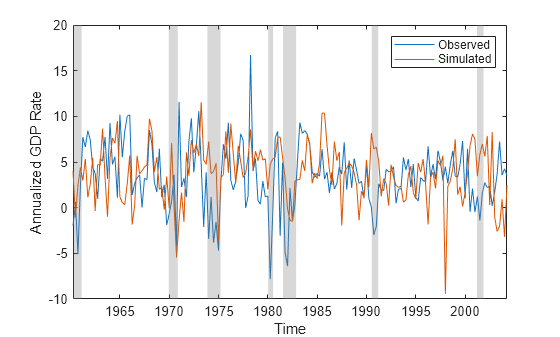
Assess estimation accuracy using simulated data from a known data-generating process (DGP). This example uses arbitrary parameter values.
Create Model for DGP
Create a fully specified, two-state discrete-time Markov chain model for the switching mechanism.
P = [0.7 0.3; 0.1 0.9]; mc = dtmc(P);
For each state, create a fully specified AR(1) model for the response process.
% Constants C1 = 5; C2 = -2; % Autoregression coefficients AR1 = 0.4; AR2 = 0.2; % Variances V1 = 4; V2 = 2; % AR Submodels dgp1 = arima('Constant',C1,'AR',AR1,'Variance',V1); dgp2 = arima('Constant',C2,'AR',AR2,'Variance',V2);
Create a fully specified Markov-switching dynamic regression model for the DGP.
DGP = msVAR(mc,[dgp1,dgp2]);
Simulate Response Paths from DGP
Generate 10 random response paths of length 1000 from the DGP.
rng(1); % For reproducibility N = 10; n = 1000; Data = simulate(DGP,n,'Numpaths',N);
Data is a 1000-by-10 matrix of simulated responses.
Create Model for Estimation
Create a partially specified Markov-switching dynamic regression model that has the same structure as the data-generating process, but specify an unknown transition matrix and unknown submodel coefficients.
PEst = NaN(2); mcEst = dtmc(PEst); mdl = arima(1,0,0); Mdl = msVAR(mcEst,[mdl; mdl]);
Create Model Containing Initial Values
Create a fully specified Markov-switching dynamic regression model that has the same structure as Mdl, but set all estimable parameters to initial values.
P0 = 0.5*ones(2); mc0 = dtmc(P0); mdl01 = arima('Constant',1,'AR',0.5,'Variance',2); mdl02 = arima('Constant',-1,'AR',0.5,'Variance',1); Mdl0 = msVAR(mc0,[mdl01,mdl02]);
Estimate Models
Fit the model to each simulated path. For each path, plot the loglikelihood at each iteration of the EM algorithm.
c1 = zeros(N,1); c2 = zeros(N,1); v1 = zeros(N,1); v2 = zeros(N,1); ar1 = zeros(N,1); ar2 = zeros(N,1); PStack = zeros(2,2,N); figure hold on for i = 1:N EstModel = estimate(Mdl,Mdl0,Data(:,i),'IterationPlot',true); c1(i) = EstModel.Submodels(1).Constant; c2(i) = EstModel.Submodels(2).Constant; v1(i) = EstModel.Submodels(1).Covariance; v2(i) = EstModel.Submodels(2).Covariance; ar1(i) = EstModel.Submodels(1).AR{1}; ar2(i) = EstModel.Submodels(2).AR{1}; PStack(:,:,i) = EstModel.Switch.P; end hold off

Assess Accuracy
Compute the Monte Carlo mean of each estimated parameter.
c1Mean = mean(c1); c2Mean = mean(c2); v1Mean = mean(v1); v2Mean = mean(v2); ar1Mean = mean(ar1); ar2Mean = mean(ar2); PMean = mean(PStack,3);
Compare population parameters to the corresponding Monte Carlo estimates.
DGPvsEstimate = [...
C1 c1Mean
C2 c2Mean
V1 v1Mean
V2 v2Mean
AR1 ar1Mean
AR2 ar2Mean]DGPvsEstimate = 6×2
5.0000 5.0260
-2.0000 -1.9615
4.0000 3.9710
2.0000 1.9903
0.4000 0.4061
0.2000 0.2017
P
P = 2×2
0.7000 0.3000
0.1000 0.9000
PEstimate = PMean
PEstimate = 2×2
0.7065 0.2935
0.1023 0.8977
Generate random paths from a three-state Markov-switching dynamic regression model for a 2-D VARX response process. This example uses arbitrary parameter values for the DGP.
Create Fully Specified Model for DGP
Create a three-state discrete-time Markov chain model for the switching mechanism.
P = [10 1 1; 1 10 1; 1 1 10]; mc = dtmc(P);
mc is a fully specified dtmc object. dtmc normalizes the rows of P so that they sum to 1.
For each regime, use varm to create a VAR model that describes the response process within the regime. Specify all parameter values.
% Constants C1 = [1;-1]; C2 = [2;-2]; C3 = [3;-3]; % Autoregression coefficients AR1 = {}; AR2 = {[0.5 0.1; 0.5 0.5]}; AR3 = {[0.25 0; 0 0] [0 0; 0.25 0]}; % Regression coefficients Beta1 = [1;-1]; Beta2 = [2 2;-2 -2]; Beta3 = [3 3 3;-3 -3 -3]; % Innovations covariances Sigma1 = [1 -0.1; -0.1 1]; Sigma2 = [2 -0.2; -0.2 2]; Sigma3 = [3 -0.3; -0.3 3]; % VARX submodels mdl1 = varm('Constant',C1,'AR',AR1,'Beta',Beta1,'Covariance',Sigma1); mdl2 = varm('Constant',C2,'AR',AR2,'Beta',Beta2,'Covariance',Sigma2); mdl3 = varm('Constant',C3,'AR',AR3,'Beta',Beta3,'Covariance',Sigma3); mdl = [mdl1; mdl2; mdl3];
mdl contains three fully specified varm model objects.
For the DGP, create a fully specified Markov-switching dynamic regression model from the switching mechanism mc and the submodels mdl.
Mdl = msVAR(mc,mdl);
Mdl is a fully specified msVAR model.
Simulate Data Ignoring Regression Component
If you do not supply exogenous data, simulate ignores the regression components in the submodels. Simulate 3 separate, independent paths of responses, innovations, and state indices of length 5 from the model.
rng(1); % For reproducibility [Y,E,SP] = simulate(Mdl,5,'NumPaths',3)
Y =
Y(:,:,1) =
5.2387 1.5297
4.4290 4.2738
1.1668 -1.2905
-0.9654 -0.2028
-0.2701 0.8993
Y(:,:,2) =
2.7737 -2.5383
-0.8651 -1.1046
-0.0511 0.3696
0.5826 -0.8926
2.4022 -0.6912
Y(:,:,3) =
3.5443 0.8768
4.9748 -0.7956
5.7213 0.8073
4.2473 0.5805
2.7972 -1.3340
E =
E(:,:,1) =
1.2387 1.5297
-0.3434 2.8896
0.1668 -0.2905
-1.9654 0.7972
-1.2701 1.8993
E(:,:,2) =
1.7737 -1.5383
-1.8651 -0.1046
-1.0511 1.3696
-0.4174 0.1074
1.4022 0.3088
E(:,:,3) =
-0.4557 0.8768
1.1150 -1.0061
1.3134 0.7176
-0.6941 -0.6838
1.7972 -0.3340
SP = 5×3
2 1 2
2 1 2
1 1 2
1 1 2
1 1 1
Y and E are 5-by-2-by-3 arrays of simulated responses and innovations, respectively. Rows correspond to time points, columns correspond to variables in the system, and pages correspond to paths. SP is a 5-by-3 matrix whose columns correspond to paths.
Simulate a single path of responses, innovations, and states into a simulation horizon of length 50. Then plot each path separately.
rng0 = rng; % Store settings to reproduce state sequence. [Y,E,SP] = simulate(Mdl,50); figure subplot(3,1,1) plot(Y) ylabel("Response") grid on legend(["y_1" "y_2"]) subplot(3,1,2) plot(E) ylabel("Innovation") grid on legend(["e_1" "e_2"]) subplot(3,1,3) plot(SP,'m') ylabel("State") yticks([1 2 3])

Simulate Data Including Regression Component
Simulate exogenous data for the three regressors by generating 50 random observations from the 3-D standard Gaussian distribution.
X = randn(50,3);
Generate one random response, innovation, and state path of length 50. Specify the simulated exogenous data for the submodel regression components. Plot the results.
rng(rng0); % Reproduce state sequence in previous simulation. [Y,E,SP] = simulate(Mdl,50,'X',X); figure subplot(3,1,1) plot(Y) ylabel("Response") grid on legend(["y_1" "y_2"]) subplot(3,1,2) plot(E) ylabel("Innovation") grid on legend(["e_1" "e_2"]) subplot(3,1,3) plot(SP,'m') ylabel("State") yticks([1 2 3])
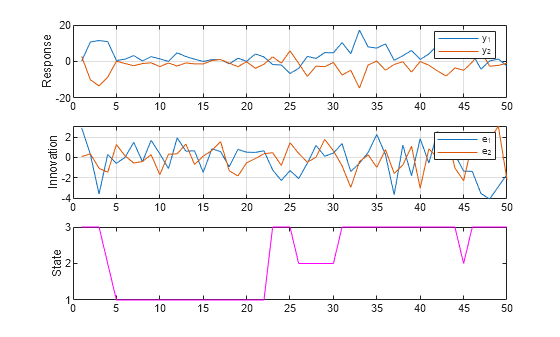
Consider the model in Simulate Paths from Model with VARX Submodels.
Create Fully Specified Model
Create the Markov-switching model excluding the regression component.
P = [10 1 1; 1 10 1; 1 1 10];
mc = dtmc(P);
C1 = [1;-1];
C2 = [2;-2];
C3 = [3;-3];
AR1 = {};
AR2 = {[0.5 0.1; 0.5 0.5]};
AR3 = {[0.25 0; 0 0] [0 0; 0.25 0]};
Sigma1 = [1 -0.1; -0.1 1];
Sigma2 = [2 -0.2; -0.2 2];
Sigma3 = [3 -0.3; -0.3 3];
mdl1 = varm('Constant',C1,'AR',AR1,'Covariance',Sigma1);
mdl2 = varm('Constant',C2,'AR',AR2,'Covariance',Sigma2);
mdl3 = varm('Constant',C3,'AR',AR3,'Covariance',Sigma3);
mdl = [mdl1; mdl2; mdl3];
Mdl = msVAR(mc,mdl);Simulate Multiple Paths
Generate 1000 random paths of responses for 50 time steps. Start all simulations at the first state.
rng(10); % For reproducibility S0 = [1 0 0]; Y = simulate(Mdl,50,'S0',S0,'NumPaths',1000);
Y is a 50-by-2-by-1000 array of simulated response paths.
Compute Monte Carlo Distribution
For each variable and path, compute the process mean.
mus = mean(Y,1);
For each variable, plot the Monte Carlo distribution of the process mean.
figure h1 = histogram(mus(1,1,:),'Normalization',"probability",... 'BinWidth',0.1); hold on h2 = histogram(mus(1,2,:),'Normalization',"probability",... 'BinWidth',0.1); legend(["y_1" "y_2"]) title('Process Means') hold off
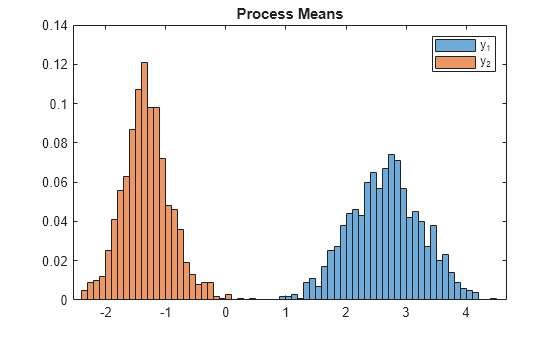
For each variable and path, compute the process standard deviation.
sigmas = std(Y,0,1);
For each variable, plot the Monte Carlo distribution of the process standard deviation.
figure h1 = histogram(sigmas(1,1,:),'Normalization',"probability",... 'BinWidth',0.05); hold on h2 = histogram(sigmas(1,2,:),'Normalization',"probability",... 'BinWidth',0.05); legend(["y_1" "y_2"]) title('Process Standard Deviations') hold off
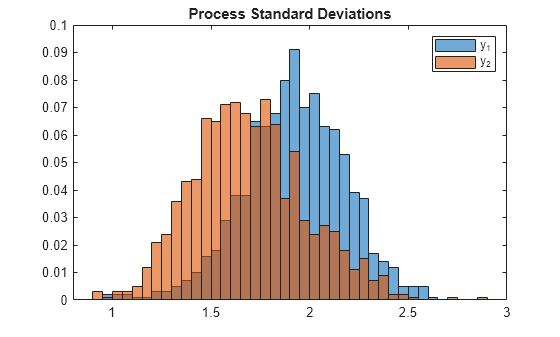
Input Arguments
Number of observations to generate for each sample path, specified as a positive integer.
Data Types: double
Name-Value Arguments
Specify optional pairs of arguments as
Name1=Value1,...,NameN=ValueN, where Name is
the argument name and Value is the corresponding value.
Name-value arguments must appear after other arguments, but the order of the
pairs does not matter.
Before R2021a, use commas to separate each name and value, and enclose
Name in quotes.
Example: 'NumPaths',1000,'Y0',Y0 simulates 1000 sample paths and initializes the dynamic component of each submodel by using the presample response data Y0.
Number of sample paths to generate, specified as the comma-separated pair consisting of 'NumPaths' and a positive integer.
Example: 'NumPaths',1000
Data Types: double
Presample response data, specified as the comma-separated pair consisting of 'Y0' and a numeric matrix or array.
To use the same presample data for each numPaths path, specify a numPreSampleObs-by-numSeries matrix, where numPaths is the value of NumPaths, numPreSampleObs is the number of presample observations, and numSeries is the number of response variables.
To use different presample data for each path:
For univariate ARX submodels, specify a
numPreSampleObs-by-numPathsmatrix.For multivariate VARX submodels, specify a
numPreSampleObs-by-numSeries-by-numPathsarray.
The number of presample observations numPreSampleObs must be sufficient to initialize the AR terms of all submodels. If numPreSampleObs exceeds the AR order of any state, simulate uses the latest observations.
Each time simulate switches states, it updates Y0 using the latest simulated observations.
By default, simulate determines Y0 by the submodel of the initial state (see S0):
If the initial submodel is a stationary AR process without regression components,
simulatesets presample observations to the unconditional mean.Otherwise,
simulatesets presample observations to zero.
Data Types: double
Initial state probabilities, specified as the comma-separated pair consisting of 'S0' and a nonnegative numeric vector of length numStates.
simulate normalizes S0 to produce a distribution.
simulate selects the initial state of each path from S0 at random. To start from a specific initial state, specify a distribution with a probability mass of 1 in that state.
By default, simulate sets S0 to a steady-state distribution computed by asymptotics.
Example: 'S0',[0.2 0.2 0.6]
Example: 'S0',[0 1] specifies state 2 as the initial state.
Data Types: double
Predictor data used to evaluate regression components in all submodels of Mdl, specified as the comma-separated pair consisting of 'X' and a numeric matrix or a cell vector of numeric matrices.
To use a subset of the same predictors in each state, specify X as a matrix with numPreds columns and at least numObs rows. Columns correspond to distinct predictor variables. Submodels use initial columns of the associated matrix, in order, up to the number of submodel predictors. The number of columns in the Beta property of Mdl.SubModels( determines the number of exogenous variables in the regression component of submodel j)jnumObs, then simulate uses the latest observations.
To use different predictors in each state, specify a cell vector of such matrices with length numStates.
By default, simulate ignores regression components in Mdl.
Data Types: double
Output Arguments
Simulated response paths, returned as a numeric matrix or array. Y represents the continuation of the presample responses in Y0.
For univariate ARX submodels, Y is a numObs-by-numPaths matrix. For multivariate VARX submodels, Y is a numObs-by-numSeries-by-numPaths array.
Simulated innovation paths, returned as a numeric matrix or array.
For univariate ARX submodels, E is a numObs-by-numPaths matrix. For multivariate VARX submodels, E is a numObs-by-numSeries-by-numPaths array.
Simulated state paths, returned as a numObs-by-numPaths numeric matrix.
References
[1] Chauvet, M., and J. D. Hamilton. "Dating Business Cycle Turning Points." In Nonlinear Analysis of Business Cycles (Contributions to Economic Analysis, Volume 276). (C. Milas, P. Rothman, and D. van Dijk, eds.). Amsterdam: Emerald Group Publishing Limited, 2006.
[2] Hamilton, J. D. "Analysis of Time Series Subject to Changes in Regime." Journal of Econometrics. Vol. 45, 1990, pp. 39–70.
[3] Hamilton, James D. Time Series Analysis. Princeton, NJ: Princeton University Press, 1994.
Version History
Introduced in R2019b
MATLAB Command
You clicked a link that corresponds to this MATLAB command:
Run the command by entering it in the MATLAB Command Window. Web browsers do not support MATLAB commands.
Select a Web Site
Choose a web site to get translated content where available and see local events and offers. Based on your location, we recommend that you select: .
You can also select a web site from the following list
How to Get Best Site Performance
Select the China site (in Chinese or English) for best site performance. Other MathWorks country sites are not optimized for visits from your location.
Americas
- América Latina (Español)
- Canada (English)
- United States (English)
Europe
- Belgium (English)
- Denmark (English)
- Deutschland (Deutsch)
- España (Español)
- Finland (English)
- France (Français)
- Ireland (English)
- Italia (Italiano)
- Luxembourg (English)
- Netherlands (English)
- Norway (English)
- Österreich (Deutsch)
- Portugal (English)
- Sweden (English)
- Switzerland
- United Kingdom (English)